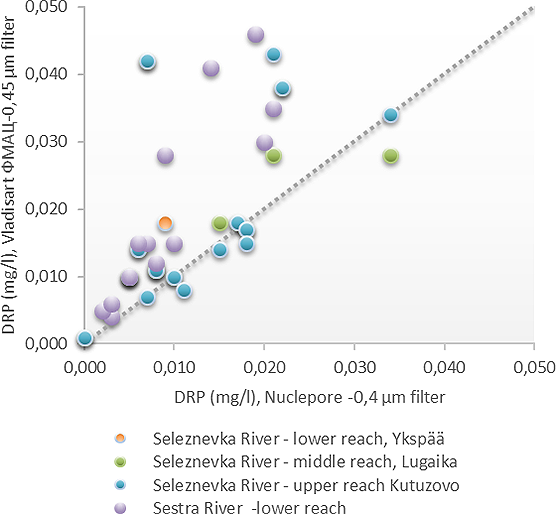One of the key issues in SEVIRA-project is to obtain reliable data from rivers. This means not only necessity to carry out accurate measurements but to analyze the samples in laboratories and to compare the possible differences in between various methods used. The main goal is finally to obtain reliable information of the river loads.
A large portion of phosphorus transported by rivers to the Gulf of Finland is bound to suspended sediment particles and organic matter and is thus not directly available to algae. Rivers also transport so called dissolved reactive phosphorus (DRP), which is more readily algal available, i.e. eutrophying than particulate phosphorus. While particulate phosphorus has to be transformed into a dissolved form before it can be taken up by algae, DRP immediately fuels the growth of algal blooms in spring and summer when the temperature and light conditions are favorable in the Gulf of Finland.

The determined dissolved reactive phosphorus (DRP) concentration varies depending on the filter used in the laboratory.
In the SEVIRA-project river water samples are analysed both in Russian and Finnish laboratories. The phosphorus analyses methods are slightly different between the laboratories, which may affect determined river water DRP concentrations and loads.
In both laboratories, the water samples are pretreated for the DRP analysis by filtering the sample through a filter to trap suspended sediment particles as well as particle-bound phosphorus from the water. The material of the filter and it´s pore size has a crucial role on how much phosphorus remains in the water sample after the filtration. In the laboratory of St. Petersburg Centre for Hydrometeorology and Environmental Monitoring the commonly used filter is called “Vladisart ФМАЦ-0.45µm”, whereas in Finland the “Nuclepore polycarbonate filter 0.4 µm” is often used. Both the material and the pore size of these filters differ. According to the Finnish experience, the “Nuclepore” filters are the most efficient in capturing particulate matter from river waters. Therefore, we expected that the use of the “Vladisart” filter produces higher DRP concentrations than those determined with the “Nuclepore” filter. In other words, the smallest particles are more likely to go through the “Vladisart” filter, resulting in overestimating the true dissolved phosphorus.
In the SEVIRA project we have been testing the impact of two analysis methods on determined DRP concentrations. The Russian laboratory analysed the DRP concentration of 47 water samples by using the both analysis methods. The water samples were collected from four monitoring station from the Seleznevka and Sestra Rivers during 2019.
The mean DRP concentration of the rivers was 12 µg/l, when the Nuclepore filter was used and 20 µg/l when the Vladisart filter used, that is using “Vladisart” filters produced on average 60 % higher DRP concentration than using “Nuclepore” filters in the studied rivers. If the future results corroborate the findings presented here, we recommend paying attention to the filter choice in order to get a reliable view of the directly algal available phosphorus entering from NW Russia to the Gulf of Finland.